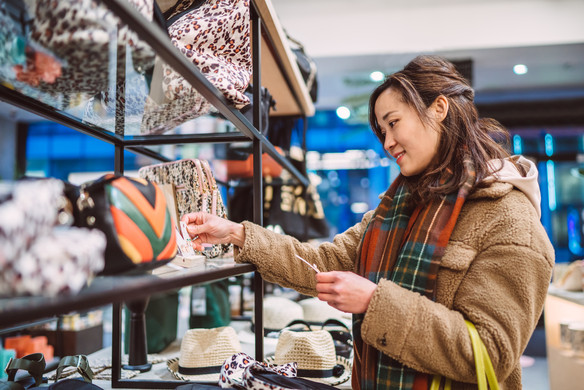Table of contents
Finding ways to increase sales without heavily discounting products is top of mind for retailers. Product bundling is an easy and effective way to stay competitive and promote sell-through without unnecessarily discounting your products.
Product bundling involves grouping and selling products or services together as a single unit rather than selling them individually to increase your average order value. Product bundling can help you cross-sell items and clear stock to reduce carrying costs. It’s also a particularly great strategy for the holiday season. Many savvy retailers use product bundling as a creative alternative to running a sale since customers can still save with bundles, so they feel like they’re getting a bargain.
If you’re considering bundling to increase revenue and sell-through, here’s how to determine which product bundling strategies may work best for your unique business.
Pure bundling versus mixed bundling
Product bundling strategies typically fall under two main approaches: pure and mixed.
Pure bundling involves selling two or more products exclusively as a bundle, with no option for customers to purchase the items separately. An example is a dining set. The table and chairs must be bought as a set and are not available for purchase as separate items. Pure bundling creates value and promotes complete solutions or experiences, but may limit flexibility.
Mixed bundling is the opposite of pure bundling. Here, products are offered as part of a bundle and as individual items that can be purchased separately. In mixed bundling, customers can choose whether to purchase the entire bundle or select specific items. Normally, items are pricier when bought separately, thus encouraging them to opt for a better-value bundle.
Mixed bundling is more popular because it usually generates higher revenue than pure bundles, as shown by this Harvard study. This is because customers might look elsewhere when they can’t buy items separately.
Using Square for Retail, it’s easy to manage both mixed and single bundles. The individual component inventory will be tracked regardless of whether the item is sold on its own or as part of a bundle. Using the sales report, retailers can view revenue for the entire bundle itself, while in the COGS report, bundles will show up as their own items, and the cost will be calculated as the sum of all components, making it easy to understand your profit margins.
9 product bundling strategies that may help to increase revenue
Looking for product bundling inspiration? Here are nine product bundling strategies to consider.
1. Complementary bundling
Combine products that naturally go together. A classic example is pairing a hair shampoo with a conditioner. Customers often need both and would purchase them separately anyway, so you can make the purchase easier and at a more attractive price.
The key to successful complementary bundles is understanding your target audience’s needs and preferences and creating bundles that make their lives easier. Using the Square for Retail sales report, you can easily identify which products are most commonly purchased together to help inform your complementary bundles.
2. Cross-sell bundling
Introduce customers to new items by combining products from different categories. Cross-selling bundling is an effective way to combine high-demand products with low sell-through items to avoid sitting on excess inventory.
For example, a retail store may bundle a set of high-quality chef’s knives (kitchen utensils) with a collection of exotic spices (food ingredients) or a cookbook featuring international cuisines (books). Cross-sell bundling helps customers discover items they need but may not have considered otherwise.
3. New-product bundling
Bundle a new or lesser-known product with a popular item to increase its visibility and sales. Similar to cross-sell bundling, this can help customers discover products they might not have considered otherwise.
With the Square Dashboard, you can access real-time and historical data that can inform your new product bundles. For example, you can see which items are popular during specific periods or which products customers tend to buy together.
4. Tiered bundling
Offer bundles with different tiers to cater to various customer preferences and budgets. A tiered package for a gourmet food store specializing in Italian cuisine may look like this:
- Tier 1 (Pasta Night Kit): Includes two types of pasta, one jar of marinara sauce, and a bottle of olive oil.
- Tier 2 (Italian Feast): Includes all items in the first tier, plus a selection of Italian cheeses, a baguette, and a bottle of red wine.
- Tier 3 (Italian Experience Kit): Includes all items from the first two tiers, plus a selection of cured meats, a jar of pesto sauce, and a box of premium Italian chocolates.
In this example, customers who love Italian cuisine can choose from three different tiers, each offering a more extensive and luxurious Italian food experience.
Tiered bundling encourages customers to explore various packages and purchase a bundle that aligns with their preferences and budget while providing value at each tier.
5. Mix-and-match bundling
Allow customers to select items from a predefined list to create their own customized bundle so they feel in control of the purchase.
For example, a Create Your Own Snack pack may allow customers to select a specified number of snacks for a fixed price. Available snacks may be divided into categories such as chips, beverages, and candies. Customers can then mix and match items from the different categories to create their ideal snack pack for the same fixed price.
With the mix-and-match bundling strategy, you allow customers to customize their products while providing a fixed price point for convenience and value. It encourages them to explore different combinations and create their own unique product experience.
6. Seasonal bundling
Create bundles that align with holidays, seasons, or special events. Seasonal bundling is an effective way to curate gifts to make your customers’ holiday shopping easier while consolidating inventory before it becomes a liability. For example, a Christmas Home Decor bundle could include a prelit Christmas tree, an ornament set, string lights, and everything the customer may need to get their home ready for the season’s celebrations.
You can also create seasonal bundles that include exclusive or limited-edition items unavailable for individual purchase, making them more appealing.
7. Bulk purchase bundling
Offer discounts on bundles when customers buy in larger quantities. This incentivizes bulk purchases and helps increase the overall sale amount. For example, a snack shop may offer snacks in larger quantities to schools, offices, or event organizers, bundling items like chips, granola bars, and bottled drinks together at a reduced per-item cost.
8. Gift bundling
Curate bundles that are perfect for gifting occasions. This appeals to customers looking for convenient gift options. For example, a bundle that includes a plush blanket, scented candles, a hot cocoa mix, or popcorn and a movie trivia game can be the perfect gift for cozy winter nights.
9. Subscription bundling
Allow customers to sign up for a recurring subscription to receive a curated selection of products regularly. This generates recurring revenue and provides convenience to customers. A Square 2023 study revealed that total subscription sales grew 136% compared to the previous year, with subscriptions accounting for 22% of revenue for businesses selling subscriptions.
For example, a simple coffee subscription can include one bag of coffee beans and a choice of flavored syrups per month. The good news is that managing subscriptions doesn’t have to be complicated. Square for Retail allows you to create bundles of the items you’d like to include as part of a subscription service.
When to avoid product bundling
While bundling is generally a great sales strategy, it may not be a good approach in some situations. If the products you intend to bundle don’t naturally complement each other or lack customer demand, bundling might not make sense. Additionally, if bundling adds complexity to your operations or leads to reduced sales of individual products, it may be best to steer clear. Also, if personalization and customization are crucial to your customers, bundling may limit their choices. It’s important to assess your specific business context and market dynamics before deciding whether or not to implement bundling strategies.
Product bundling can be a savvy way to boost your business’s revenue. The key is understanding your customers’ wants and creating bundles that meet those needs. While at it, you can leverage the robust bundling support of Square to experiment with diverse product combinations and gain valuable insights into top-performing items and bundles.
Get started with product bundles, now available for Square for Retail Plus sellers.
![]()











